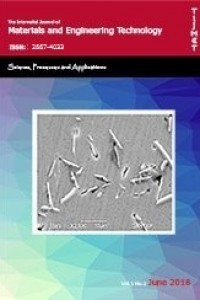EFFECT OF DIFFERENT AMOUNTS OF CARBON FIBER ADDITIVE ABS ON THERMAL DISTORTION AND COOLING TIME
EFFECT OF DIFFERENT AMOUNTS OF CARBON FIBER ADDITIVE ABS ON THERMAL DISTORTION AND COOLING TIME
LSAM, carbon fiber, thermal imaging, ABS,
___
- 1. Mellor, S., Hao, L., and Zhang, D. Additive manufacturing: A framework for implementation. Int. J. Prod. Econ., (2014), 149, 194–201.
- 2. Gao, W., Zhang, Y., Ramanujan, D., Ramani, K., Chen, Y., Williams, C.B., Wang, C.C.L., Shin, Y.C., Zhang, S., and Zavattieri, P.D. The status, challenges, and future of additive manufacturing in engineering. CAD Comput. Aided Des., (2015), 69, 65–89.
- 3. Kishore, V., Ajinjeru, C., Nycz, A., Post, B., Lindahl, J., Kunc, V., and Duty, C. Infrared preheating to improve interlayer strength of big area additive manufacturing (BAAM) components. Addit. Manuf., (2017), 14, 7–12.
- 4. Eyercioglu, O., Aladag, M., Aksoy, A., and Gov, K. Determination of The Maximum Bridging Distance in Large Scale Additive Manufacturing. 4th Int. Congr. 3d Print. (Additive Manuf. Technol. Digit. Ind., (2019), 40–48.
- 5. Kim, S., Dreifus, G., Beard, B., Glick, A., Messing, A., Hassen, A.A., Lindahl, J., Liu, P., Smith, T., Failla, J., Post, B., Bowers, J.C., Stephenson, K., Love, L., and Kunc, V. Graded infill structure of wind turbine blade core accounting for internal stress in big area additive manufacturing. CAMX 2018 - Compos. Adv. Mater. Expo, (2018).
- 6. Kim, S., Baid, H., Hassen, A., Kumar, A., Lindahl, J., Hoskins, D., Ajinjeru, C., Duty, C., Yeole, P., Vaidya, U., Dinwiddie, R., Abdi, F., Love, L., Simunovic, S., and Kunc, V. Analysis on part distortion and residual stress in big area additive manufacturing with carbon fiber-reinforced thermoplastic using dehomogenization technique. CAMX 2019 - Compos. Adv. Mater. Expo, (2019), 1–14.
- 7. Love, J.L. Utility of Big Area Additive Manufacturing (Baam) for The Rapid Manufacture Of Customized Electric Vehicles. Science (80-. )., (2014).
- 8. Tekinalp, H.L., Kunc, V., Velez-Garcia, G.M., Duty, C.E., Love, L.J., Naskar, A.K., Blue, C.A., and Ozcan, S. Highly oriented carbon fiber-polymer composites via additive manufacturing. Compos. Sci. Technol., (2014), 105, 144–150.
- 9. Liu, P., Dinwiddie, R.B., Keum, J.K., Vasudevan, R.K., Jesse, S., Nguyen, N.A., Lindahl, J.M., and Kunc, V. Rheology, crystal structure, and nanomechanical properties in large-scale additive manufacturing of polyphenylene sulfide/carbon fiber composites. Compos. Sci. Technol., (2018), 168, 263–271.
- 10. Ning, F., Cong, W., Qiu, J., Wei, J., and Wang, S. Additive manufacturing of carbon fiber reinforced thermoplastic composites using fused deposition modeling. Compos. Part B Eng., (2015), 80, 369–378.
- 11. Sudbury, Z., Duty, C., Kunc, V., Kishore, V., Ajinjeru, C., Failla, J., and Lindahl, J. Characterizing material transition for functionally graded material using big area additive manufacturing. Solid Free. Fabr. 2016 Proc. 27th Annu. Int. Solid Free. Fabr. Symp. - An Addit. Manuf. Conf. SFF 2016, (2016), 738–747.
- 12. Love, L.J., Kunc, V., Rios, O., Duty, C.E., Elliott, A.M., Post, B.K., Smith, R.J., and Blue, C.A. The importance of carbon fiber to polymer additive manufacturing. J. Mater. Res., (2014), 29 (17), 1893–1898.
- 13. Polyzos, E., Katalagarianakis, A., Van Hemelrijck, D., and Pyl, L. Delamination analysis of 3D-printed nylon reinforced with continuous carbon fibers. Addit. Manuf., (2021), 46, 102144.
- 14. Eyercioglu, O., Aladag, M., and Sever, S. Temperature Evaluation and Bounding Quality of Large Scale Additive Manufacturing Thin Wall Parts. Sigma J Eng Nat Sci, (2018), 36 (3), 645–654.
- Yayın Aralığı: Yılda 2 Sayı
- Başlangıç: 2018
- Yayıncı: Necip Fazıl YILMAZ
ANALYSIS OF WIND TURBINE BLADE PITCH ANGLE CONTROL WITH FUZZY LOGIC
EFFECT OF DIFFERENT AMOUNTS OF CARBON FIBER ADDITIVE ABS ON THERMAL DISTORTION AND COOLING TIME
Ömer EYERCİOĞLU, Engin TEK, Mehmet ALADAĞ, Gülağa TAŞ
Nasır MOHAMMED TAHIR, Adamu Umar ALHAJİ, Ibrahim ABDULLAHİ
Oğuzcan GÜZELİPEK, Tuğrul SOYUSİNMEZ, Furkan ÇETİN
ANALYSIS OF MECHANICAL BEHAVIOR OF TERMOPLASTIC COMPOSITES
Ali Taner KUZU, Elifnur KÖSEMEN, Aysu Hande YÜCEL, Mustafa BAKKAL
INVESTIGATION OF THE HUB DIAMETER EFFECT ON PROPELLER THRUST
Enes COŞKUN, Mehmet Hanifi DOĞRU
EFFECT OF PROPELLERS NUMBERS AND HORIZONTAL DISTANCE IN DESIGN OF VTOL
Mustafa VARKİ, Eyüp YETER, Mehmet Hanifi DOĞRU
Mahmut Furkan KALKAN, Murat ARTAN, Hasan Mithat DELİBAŞ, Abdulcabbar YAVUZ, Necip Fazıl YILMAZ
Doğan ACAR, Salim Levent AKTUĞ, Kemal KORKMAZ, Salih DURDU, Ömer Necati CORA
